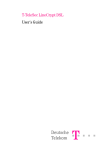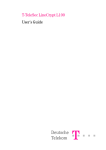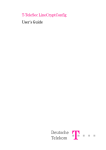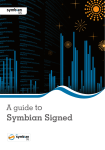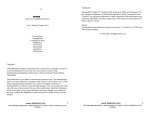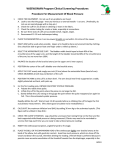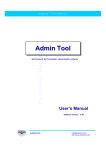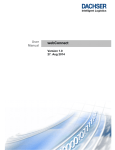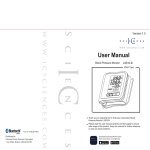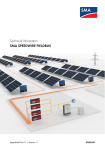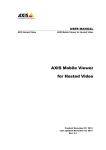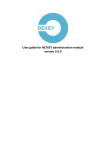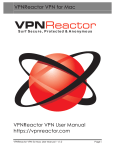Download T-TeleSec LineCrypt L
Transcript
T-TeleSec LineCrypt L User's Guide Contents General.............................................................................................................................3 Overview of pictorial symbols..................................................................................3 Safety notes................................................................................................................3 Power failure.............................................................................................................4 Function Overview..........................................................................................................5 Assembly.........................................................................................................................6 Included in delivery...................................................................................................6 Preparation.................................................................................................................7 Installation place.....................................................................................................11 Start-Up .........................................................................................................................12 CD/configuration software. .................................................................................12 Operation.......................................................................................................................13 LED on the top side................................................................................................13 LED on the rear side ..............................................................................................14 Technical Data..............................................................................................................15 Glossary.........................................................................................................................16 1 Registered trademarks, trademarks, and service names are used in this manual. Even if they are not marked as such, the relevant protection regulations apply. IDEATM is a trademark of Ascom Systec AG 2 General General We strongly recommend that you read this user manual before using LineCrypt. Deutsche Telekom cannot be held liable for any possible damage caused to the device or other facilities arising from the failure to follow the instructions in this manual. Overview of pictorial symbols Safety symbol to warn against danger for people and property is identified with a triangular warning sign. Safety notes • Do not open the LineCrypt. By opening the four screws on the base of the housing you may endanger the user and any warranty claim will be waived. • Allow no liquids to seep into the LineCrypt. • Assemble the device as described in the section “Assembly”. • • • • • • Do not plug in or detach any connections to the LineCrypt during a thunderstorm. The LineCrypt is only intended for use in dry indoor areas. Lay the cables in such a way that they cannot be stood on or tripped over by anyone. Before any maintenance work on the LineCrypt pull out the mains plug. Only terminal equipment that delivers SELV voltage and/or corresponds with ETS 300 047 may be connected to the LineCrypt L. Connect the device to a freely accessible earthed socket so that you can pull out the mains plug without delay when required. 3 General Power failure The configuration remains unchanged in case of a power failure. The LineCrypt L is not provided with an emergency operation. In the event of a power failure you cannot communicate via the LineCrypt L. 4 Function Overview Function Overview The T-TeleSec LineCrypt L provides protected data transfer via IP-networks Ethernet. The LineCrypt L acts as a link between a protected internal network and an unprotected external network. The LineCrypt L is based on IP communication. That means: All other protocols, IPX for example, are not forwarded between internal and external sides by LineCrypt L. LineCrypt L transfers the encrypted data through an IP Tunnel. In this way, two or more LineCrypt in an unprotected network allow a protected Virtual Private Network (VPN) to be set up. The LineCrypt L can set up IP tunnels to LineCrypt L, DSL and SoHo. The option of unencrypted connections with other IP equipment can also be configured. Ethernet LineCrypt L Router / Gateway Ethernet Internet Router / Gateway LineCrypt L Fig. 1: LineCrypt protecting your network 5 Assembly Assembly Included in delivery Open the packaging and check that the contents is complete. 1 LineCrypt L with mains cable and Chip card 1 Crossed Ethernet connection cable with RJ45 plug 1 Serial PC cable with mini DIN 8 plug 1 CDROM with LineCryptConfig software for Windows 95/98/ME/NT/2000/ XP and operating instructions 1 Connection scheme for LineCrypt L 1 Drilling template 2 Dowels and 2 screws for wall mounting 6 Assembly Preparation LineCrypt T−TeleSec Connect the cable to the LineCrypt according to the connection scheme. 110 ... 230 V Lokales Management PC V.24 Router Hub Internet 10BaseT extern 10BaseT intern Fig. 2: Connection scheme, LineCrypt L Plug the connection to your internal network into the 10BaseT internal socket. The connection to InternetGateway is made via the 10BaseT external socket. As the pin assignment of the Ethernet socket corresponds to the pin assignment of a network card, the following applies for the cable to be used: • Use a crossed cable when connecting to a network card (e.g. PC). • Use an uncrossed cable when connecting to a hub or an Ethernet switch. Contact 1,2 3 4,5 6,7,8 Line Transmission lines (LineCrypt transmits) Not used Reception lines (LineCrypt receives) Not used Table 1: Allocation of the RJ-45 plug If you wish to manage the LineCrypt L locally, plug the PC cable into the mini DIN 8 socket ”[ ... ]” for the local management. 7 Assembly 10BaseT extern 10BaseT intern [...] Fig. 3: Overview of sockets If the authorizations based on the certificate number, your communications partner requires this number. You can find the certificate number directly on the Chip card (“enc.” at end of number) or you can read it with the help of a PC and the configuration software from the LineCrypt. Fig. 4: Chip card, type NetKey Card with certificate number 991715387 To remove the Chip card, first open the lock by removing the housing cover. Using a small phillips head screwdriver to unscrew the central locking screw from the housing cover. 8 Assembly Fig. 5: Unscrewing the cover Now remove the cover horizontally until the limit stop (approx. 9 mm) and then lift it up. To remove the Chip card, pull the card lock out. 2. 1. Fig. 6: Removing the cover Now remove the Chip card and note the Certificate ID. Plug the Chip card back into the card slot. 9 Assembly 1 2 4 Card lock 3 Chip card Fig. 7: Chip card installation If the Chip card should remain permanently in the LineCrypt L, put the card lock back into its operational position. Assemble the cover to the device and fix it with the screw. 10 Assembly Installation place Place or hang the LineCrypt L in a suitable place. For wall mounting, please use the enclosed drilling template and mount the LineCrypt with the sockets on the underside. The installation place should be dry and free from dust. The LineCrypt is designed for an environmental temperature range of +41°F to +104°F. Therefore, do not expose the LineCrypt in direct sunlight and be sure that there is sufficient ventilation. 11 Start-Up Start-Up After the appropriate installation, connect the LineCrypt L with the mains cable plug to a earthed socket. The LineCrypt L perform a self-test. After 10 to 15 seconds it will start up normal operation. It is not possible to set up connections with other equipment in the delivery status. To be able to configure encrypted connections with other LineCrypt equipment or unencrypted connections with other Ethernet devices, a corresponding configuration of the LineCrypt L is required. Use the provided PC program “lcc” to configure the LineCrypt. Via the local management you also have the option of configuring authorized system administrators for remote maintenance. CD/configuration software. The settled CD contains the configuration software for the LineCrypt L, the operating instructions for the software as well as further documents. Latest information can be found in the file “readme.txt” 12 Operation Operation LED on the top side On the top side of the LineCrypt there are three multi-colored light-emitting diodes (LED), which are labeled, On, I and II. The On LED signals the ready status of the equipment. The I LED serves to display the data traffic on the network. The II LED serves to display key exchanges and faults in the equipment management. LED On Green light Orange light Orange blinking 1x 2x 3x 4x 5x 8x 9x LED I Red blinking Green blinking LED II Orange light Green light Red light Orange blinking Red blinking No Chip card plugged in Valid Chip card plugged in Authorization file/configuration missing Problem with the Chip card. Recovery: Plug Chip card in properly, or change Chip card (TeleSec NetKey Card 2.x) Internal error detected during self-test Encrypted data traffic Unencrypted data traffic Key exchange in progress Key exchange successful Key exchange failed Configuration fault Configuration fault 13 Operation LED on the rear side On the rear side there are four LED. Two of the LED (green and yellow) provide information about the status of the peer Ethernet interface and have the following meaning: 14 • Yellow: The Ethernet connection is intact. • Green: Data is being transferred. Technical Data Technical Data Power supply 110 to 230 V~ Power consumption Max. 5 VA Environmental temperature +41 °F to + 104 °F +5 °C to + 40 °C Ethernet interface Ethernet interfaces 2 x 10BaseT (10 Mbps, half duplex / full duplex) with Western RJ45-WE8/8 sockets PC interface V.24, Mini DIN 8 Chip card T-TeleSec NetKey Card (with TCOS 2.x) Payload data encryption IDEA, DES or Triple-DES Authentication RSA Table 2: Technical data 15 Glossary Glossary C Certificate Authenticated allocation of a public key for an identity expressed by the digital signature of a Trust Center (of Deutsche Telekom AG). Each TTeleSec NetKey Card has an individual certificate Certificate ID Number in a certificate that provides the certificate with unambiguous identification. Company Card →TCOS Chip card that, unlike the →NetKey Card, contains information about a closed user group. Company Cards can be obtained from Deutsche Telekom if required. Connection scheme Schematic diagram of possible connection variants. E EMC – Electromagnetic compatibility The ability of an appliance, installation, or system to function satisfactorily in the electromagnetic environment without introducing electromagnetic interference to any appliance or system in that environment (quoted from the EC EMC guideline, article 1, clause 4). Ethernet The most widely used →LAN standard (Local Area Network). Supports data rates of up to 10 Mbps (10Base-T) or 100 Mbps (100Base-T). I IP 16 (Internet Protocol) The task of the Internet Protocol (IP, layer 3) is to transport data packets from a sender to a receiver across several networks. The transmission is packet-oriented, connectionless, and non-guaranteed. The data packets Glossary (also called datagrams) are transported by the IP as independent data packets (even in the case of identical senders and receivers). IP guarantees neither observance of a particular sequence nor delivery to the receiver (that is, datagrams can be lost on account of network overload, for example). There are no receive acknowledgements on the IP layer. IP Network Network based on the Internet Protocol. Every device in the network is addressed through an IP number. IP Tunnel A connection between two subnetworks, which conceals the precise addresses of the communication partners. At the start of the tunnel, all data packets receive an additional header that refers to the tunnel end. Here the external frame is removed and the original data packet is forwarded to its actual receiver. L LAN (Local Area Network) A spatially restricted network. The most widely used LAN standard is →Ethernet. LED – Light-Emitting Diode For displaying the operational status of the device and of the connection. LineCrypt Company Card Special chip cards with information on closed user groups. Can be obtained from Deutsche Telekom if required. N NetKey Card SmartCard with → TCOS Operating System. The private asymmetrical key and a →Certificate for →Authentication awarded by the Deutsche Telekom →TrustCenter is stored on the → NetKey Card. 17 Glossary T TCP/IP (Internet Protocol and Transmission Control Protocol) TCP is a connection-oriented transport protocol for use in packet switched networks. The protocol builds on the IP protocol, supports the functions of the transport layer, and establishes a secure connection between the entities before data transfer. TCOS (TeleSec Chip card Operating System) Operating system for processor-controlled Chip cards (smart cards). V VPN (Virtual Private Network) A protected virtual sub-network is set up in an unprotected network using encryption mechanisms. 18 Index Authentication 15 Certificate ID 9, 16 Chip card 6, 8ff., 13, 15, 18 Connection scheme 6, 16 drilling template 11 Environmental temperature 15 Ethernet 6f., 12, 14ff. IDEA 15 IP Network 17 IP Tunnel 5, 17 LAN 17 LED 13, 17 NetKey Card 13, 15, 17 Operating System 17f. RSA 15 self-test 12f. TCP/IP 18 VPN 5, 18 19 Important telephone numbers In the event of malfunctions: Sales enquiries: Please enter the telephone number when handing over the unit. The LineCrypt fulfils the requirements of the following EU Directive: 1999/5/EG For this reason the LineCrypt bears the CE mark. Responsible for content: T-TeleSec Products Further information : Internet http://www.telekom.de/t-telesec e-mail [email protected] Issued by: Deutsche Telekom AG Edition: 17.11.03 Subject to change without notice





















